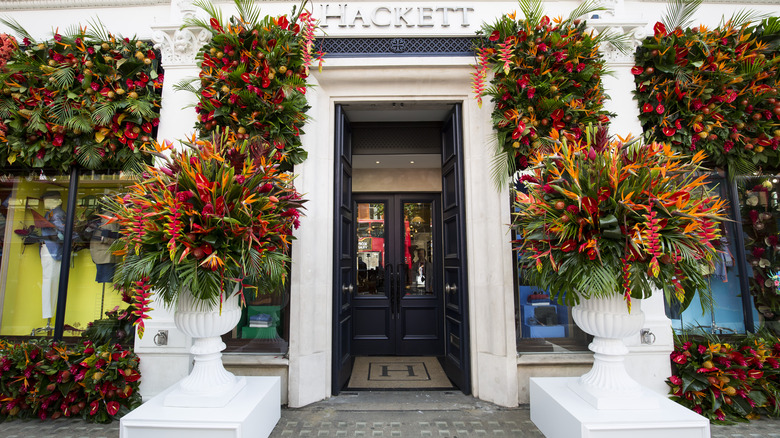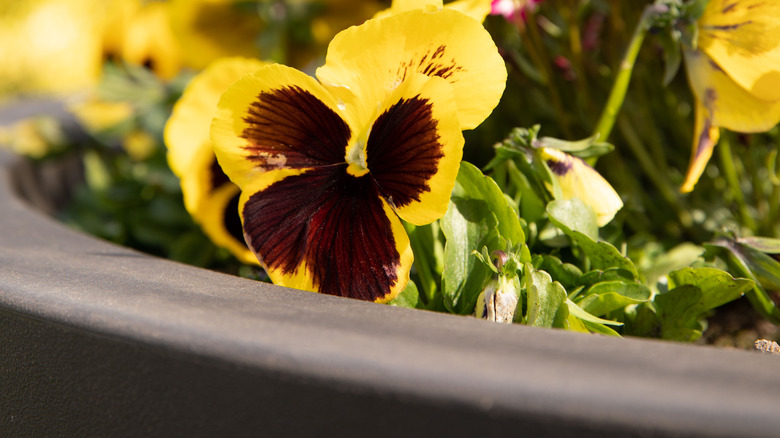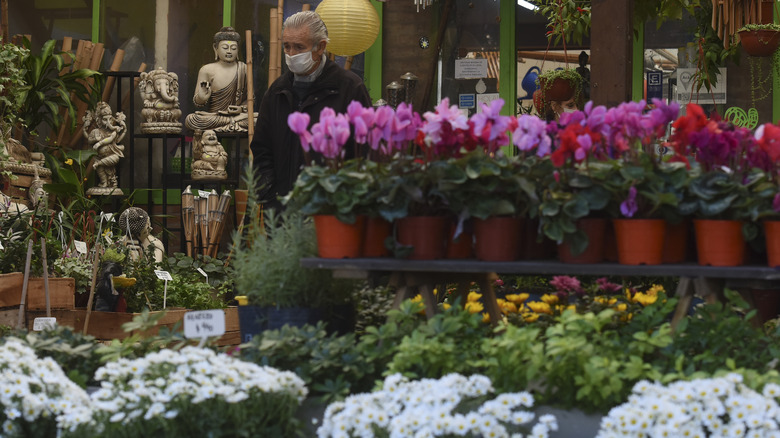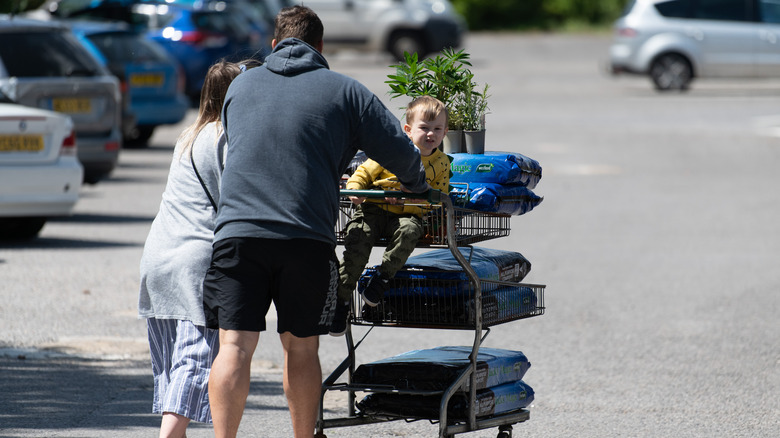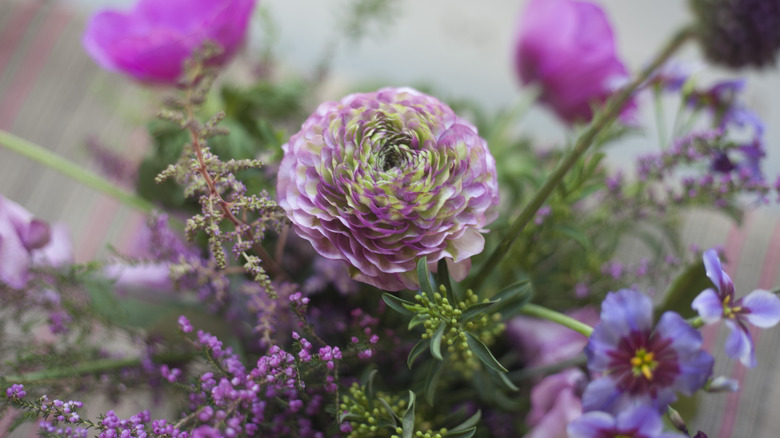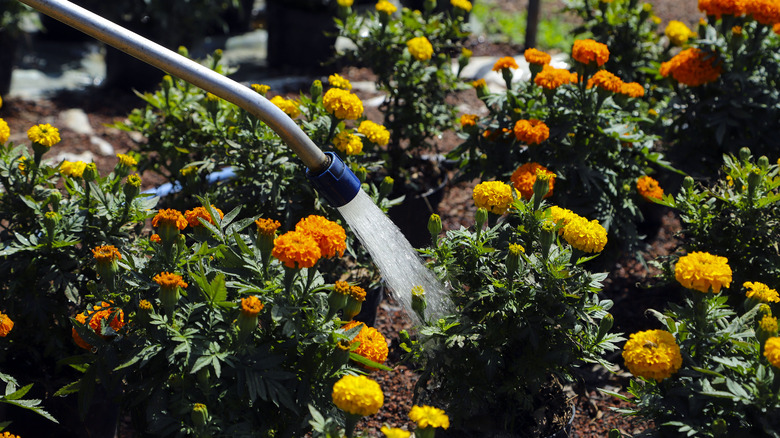Secrets To Planting The Perfect Hanging Basket
Floral hanging baskets are a great way to jazz up any deck, porch, patio, or area that needs a pop of color and some livelihood. Buying them premade from a local store or roadside vendor is an easy way to add them to your landscape or indoor space, but making your own can be fun and fulfilling while keeping a few things in mind will help you enjoy your flowers all season long.
Basket arrangements dry out quicker than plants rooted in the ground, so they need to be watered more frequently than a regular flowerbed. Garden Therapy recommends using a bottle or bulb self-watering system and adding a plastic liner to help keep moisture in. You can also buy self-watering planters, which are designed to keep soil moist for 1-3 weeks at a time through a reservoir that feeds the plant beginning at the roots and working upwards. And if the soil dries out, simply place the whole pot in a tub of water for a two-hour soak.
Another thing to keep in mind is that plants have varying needs regarding sun exposure, fertilizer, and soil. That's why it's important to read the descriptive tags that accompany plants and make sure your grouping can get along happily in one container. If you plan on having many plants, ensure the hook holding the hanging basket is firmly secured to ensure safety, says Gardening Mentor. These baskets can get pretty heavy when watered.
Choosing the right container and the right place
Finding just the right container for your arrangement can be as easy as going to the store and choosing from the variety available. There are plain pots, specialty ones, and even bags designed to hang up that hold plants so you can grow a garden vertically. Often, a less expensive route is to buy a metal or wire hanging basket lined with coconut fiber, landscape fabric, or sphagnum moss. Finding something around the house can work too. Allow your creative side to show! Modify old shoes and boots, or a funky vintage planter... as long as it can hold soil and allows for drainage, anything goes! The Gardening Cook says that recycled items often make the best planters and can be a fun, creative way to show off your blooms.
Hanging baskets are versatile in that they can hang just about anywhere — from a fence, a porch roof, an indoor ledge, a tree branch... As long as the plants get adequate sunlight, shade, and water, they'll be happy. About 5 feet off the ground is ideal for visual impact, according to Gardening Mentor. And remember to keep the weight, especially when watered, of the arrangement in mind.
Picking plants for your hanging container
A visit to the local plant nursery or farmers market is an excellent source of inspiration when deciding what plants to put in your hanging basket. If you're ordering plants or seeds online, know your USDA Hardiness Zone beforehand. It can become overwhelming, so it's a good idea to have a color scheme in mind and an idea of where the planter will reside so that you can choose plants that will thrive in that location. Although there are endless options, some of the best flowers for mixed arrangements include petunias, begonias, and pansies, according to Love the Garden. Adding leafy or blooming trailing plants will enhance the beauty of your basket.
Once you've decided on the colors you'd like, begin by choosing plants with similar requirements for optimal growth. Also, not all blooms last a full season, so it's good to ask questions if you have any concerns about how long your plants will flower. Be careful not to overcrowd your planter by putting too many in the container. The number of plants that can fit comfortably depends on the size of the basket. It's generally fine to place plants every inch for the diameter of the container. Small Space Gardening Basics explains that for a 12-inch pot, it's usually safe to have up to 12 plants.
Filling the basket with all the right stuff
Line the bottom planter with landscaping fabric, moss, coconut shreds, or pine cones to help keep the soil moist. According to Love the Garden, using a small plate along with the liner can also help water not to run straight through. Next, fill the container about half full with a potting mix designed for use with container plants. Begin with your trailing plants on the outermost edge of the pot, saving the inner area for your colorful blooms. Remember the 1-inch apart rule to make sure the planter looks full without being overcrowded.
When selecting a potting mix, look for one made for use in containers for the best results. Dirt from your yard is not suitable and will not encourage potted plants to thrive. Most people use potting mix and potting soil interchangeably, but they're actually very different (with potting mix being the one you want). Patio Garden Life explains that potting soil may contain weeds and contaminants or diseases, while potting mix is sterile and doesn't actually contain any soil; instead, it is an aerated, lightweight blend of organic materials and is often laced with fertilizer.
Maintaining your beautiful plants
Container plants need help with photosynthesis (making their own food). This is because, unlike those in the ground, they can't draw nutrients from the soil, so they benefit from supplementation or fertilizer, according to Almanac. Some potting mixes contain fertilizer, which is added to provide micronutrients to the plants and assist in the food-making process. But adding too much can burn the roots, so make sure to let the original fertilizer get used up before adding any more.
Whether you decide to use an organic or inorganic product, it's important to understand which is best suited for your particular plants. Make sure plants are well-hydrated before supplementing them, and then water them again right after for the nutrients to reach the roots. If the leaves or petals are droopy or wilting, water the plant well and wait for it to rebound before adding anything to the soil.
Handling common issues with mixed plant baskets
Hanging baskets dry out quickly and need frequent, regular watering. But if you see the water running straight through and out the bottom, this is a sign that the plants are at risk. Most likely, the roots have become messy and entangled with no more room to grow and are unable to absorb any water or nutrients. Eventually, the plant will wither and fail. Old World Garden Farms describes this problem as one of starvation that no amount of fertilizer can fix. Once this process is underway, saving the plants is not guaranteed, but it might be possible by repotting them into a larger container with fresh potting mix and room to grow.
Other common issues involve under- or over-fertilization and watering. Both require consistency for plants to flourish all season long. Another way to ensure your hanging basket stays full and beautiful is to pinch and pluck away, or deadheading, the wilted and dead flowers. According to Tilly Design, this is because plants focus on propagation as flowers die off, and the pruning process requires the plant to produce new blooms to ensure new seedlings. If collecting seeds is your desire, stop deadheading at the end of the growing season. Either way, doing so will help your hanging basket stay beautiful for months.
